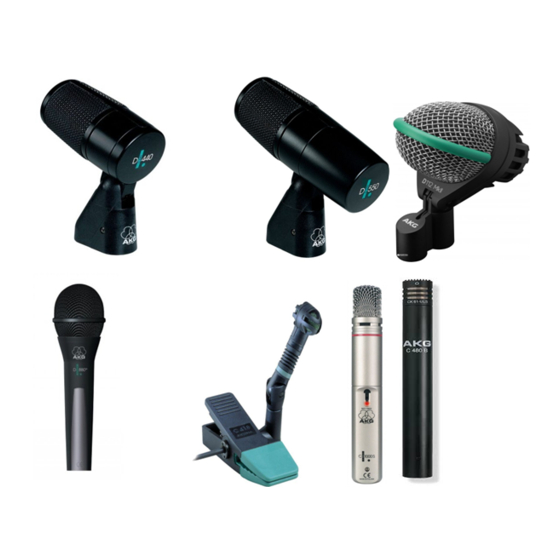
Advertisement
Quick Links
Advertisement

Summary of Contents for AKG Drum Set Micing
- Page 1 Micing the Drum Set...
- Page 2 NTRODUCTION In the modern studio there is no more complex job for the engineer than micing the drum set. Musically, the drum set and bass form the rhythmic underpinning of any jazz, pop or rock musical performance. In the final mix, it can be in the back- ground, foreground or well out front, depending on the needs of the music.
- Page 3 This, in short, is a description of a typical modern drum set. Figure 1 shows what it looks like from the viewpoint of the audience. Figure 1 In this White Paper we will discuss micing the drum set largely from the point of view of AKG’s highly regarded studio mics. We also want to introduce a new family of low-cost dynamic microphone models that are so good you’d think they were condensers! These are the models D440, D550 and D660;...
- Page 4 In the old days the AKG D12 dynamic was one of the mainstays of kick drum micing; today, the D112 is the modern version of that microphone. With its carefully engineered bass resonance cham- ber the D112 can handle any kick drum with ease. If you want to use a condenser with ultrawide low frequency capability, we suggest the C4000B, with its 0.5% THD overload point of 145 dB.
- Page 5 directions on the hi-hat and big tom), the sound will “open up” and will seem wider on the repro- duced stereo stage. Details here are shown in Figure 4. By the way, good drummers often know more about drum micing than many engineers think they do -- at least they know what has worked well for them in the past.
- Page 6 If you’re going straight to stereo you will also have to make some processing decisions for the drum tracks. Avoid any rever- beration; you probably won’t need it since there is enough overhand in the basic sound itself. A final point regarding recording levels: Mics that are close-in on a drum set will usually be sampling very high level sound fields.
- Page 7 Putting it on Tape: Our microphone count is now up to six, so if you are tracking, lay down one mic per tape track, again, without processing. In your monitor mix, or if you are making a direct-to-stereo recording, carefully pan the two new elements into the stereo soundstage at positions that match their actual positions in the drum set as seen from the front.
- Page 8 The setup, as we have described it, is shown in Global micing in a live studio, front view: Figure 8A and B. Do we have to stop here? Obviously not; we can add as many mics as we have remaining tracks. Another useful one to add would be a cardioid looking down on the head of the snare at a distance of about 8 to 10 inches -- but far enough back so as not to both-...
- Page 9 Global micing in a live studio, plan view: Figure 8B...
- Page 10 The Microphones we Recommend: We will show you the basic response curves and directional data for the microphones recommended in this White Paper. They have all earned their merits in studios throughout the world. Good drumming and good micing! D440 Frequency Range: 60Hz to 20kHz Polar Pattern: Cardioid Sensitivity: 2.5mV/Pa (–52dBV re 1V/Pa)
- Page 11 C418 Frequency Range: 50Hz to 20kHz Polar Pattern: hypercardioid Sensitivity: 2.5mV/Pa Equivalent Noise Level: 34dB-A (DIN45412) Electrical Impedance: 200 Recommended load impedance: 1,000 Maximum SPL for 1% THD: 131dB Power Requirement: 9–52V Size: 3x1.4 in. (75x35mm) including clamp Net Weight: 2.3 oz. (62g) C1000S Frequency Range: 50Hz to 20kHz Polar Patterns: cardioid, hypercardioid with PPC 1000...
- Page 12 AKG Acoustics, U.S. • 914 Airpark Center Drive • Nashville • TN 37217 • Tel: (615) 620-3800 • Fax: (615) 620-3875 Visit our Web Site at www.akg.com...













Need help?
Do you have a question about the Drum Set Micing and is the answer not in the manual?
Questions and answers